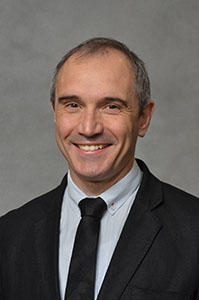Dentistry researchers advancing the science of prosthetic limbs

School of Dentistry Professor Conrado Aparicio, PhD, is leading a research team focused on reducing infection rates for patients with bone-integrated prosthetic limbs. As a mechanical engineer with deep experience advancing the science of dental implants, he is the lead investigator on a new $750,000 grant from the U.S. Department of Defense.
 “This emerging approach to prostheses holds great promise for patients,” he said. “Much like dental implants, which are anchored into the jaw or maxilla, bone-anchored artificial limbs give patients a prosthesis that is biomechanically sound and highly functional. And there are proven psychological effects for patients as well.”
“This emerging approach to prostheses holds great promise for patients,” he said. “Much like dental implants, which are anchored into the jaw or maxilla, bone-anchored artificial limbs give patients a prosthesis that is biomechanically sound and highly functional. And there are proven psychological effects for patients as well.”
Bone-anchored (or osseointegrated) prostheses involve surgery to implant a metal rod, or anchor, directly into the bone of a residual limb. A metal abutment is later attached to the rod in a second surgery. The abutment exits the skin, where a prosthetic limb is attached. This stable connection to the bone allows weight to be transferred directly to the patient’s skeletal system. Despite their functional advantages, such devices are plagued by high infection rates, which has limited their widespread application.
Aparicio’s team of scientists and orthopedic surgeons focuses on preventing infection where the metal abutment exits the skin. The challenge, according to Aparicio, is forging a strong and stable connection between the skin and the metal abutment so bacteria will not have access to the metal surfaces beneath the skin.
“Our lab has done a lot of work over the years on preventing peri-implantitis,” said Aparicio. “We get inspiration from our work with dental implants and molecular and cell processes that already exist in nature, including teeth, nails, claws and even antlers that go through the skin and generally do not become infected.”
 Aparicio’s team is investigating the ideal coating for the metal abutment that will instruct the cells to seal out bacteria. The project complements a second project in his lab, where a national multicenter and multidisciplinary team of researchers are developing stem cell-based therapies to stimulate skin growth and attachment on bone-anchored prostheses for amputees.
Aparicio’s team is investigating the ideal coating for the metal abutment that will instruct the cells to seal out bacteria. The project complements a second project in his lab, where a national multicenter and multidisciplinary team of researchers are developing stem cell-based therapies to stimulate skin growth and attachment on bone-anchored prostheses for amputees.
Bone-anchored prostheses present an alternative to fitting patients with socket prostheses, which fit around the remaining limb. While socket prostheses have improved dramatically in recent decades, many patients experience discomfort, irritation and report feeling unstable and are less likely to wear their prosthesis for extended periods.
The three-year project is a partnership involving the School of Dentistry, the Department of Orthopedic Surgery at the University of Minnesota and the Walter Reed National Military Medical Center in Bethesda, Maryland.
NOTE:The views expressed in this article are those of the author and may not reflect the official policy or position of the Department of the Army, Department of Defense, or the U.S. Government.